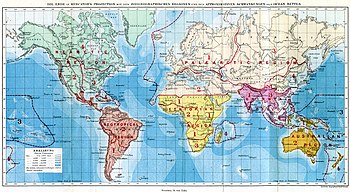
Back Biogeografie Afrikaans جغرافيا حيوية Arabic Biocoğrafiya Azerbaijani بیوجوغرافیا AZB Биогеография Bashkir Біягеаграфія Byelorussian Біягеаграфія BE-X-OLD Биогеография Bulgarian जीवभूगोल Bihari জীবভূগোল Bengali/Bangla

An bioheograpiya iyo an pag-aadal sa distribusyon kan mga espesye asin ekosistema sa heograpikong espasyo asin sa paagi kan heolohikong panahon. An mga organismo asin mga biolohikong komunidad parating nagkakalaen sa sarong regular fashion sa mga heograpikong gradients kan latitud, elebasyon, isolation asin habitat area.[1] An Phytogeography iyo an sangay kan bioheograpiya na nag-aadal sa distribusyon kan mga tinanom. An Zoogeography iyo an sangay na nag-aadal sa distribusyon kan hayop. An Mycogeography iyo an sangay na nag-aadal sa distribusyon kan fungi, siring kan mushrooms.
An kaaraman sa spatial variation sa bilang asin klase nin mga organismo bilang mahalagang marhay sa satuya sa ngunyan siring man sa satuyang amay na ancestors, mantang kita nag-aadapatar sa heterogeneous alagad mga heograpikong prediktableng kapalibotan. Biogeography is an integrative field of inquiry that unites concepts and information from ecology, evolutionary biology, taxonomy, geology, physical geography, palaeontology, and climatology.[2][3]
Sa modernong bioheograpikong pagsaligsig pigsasalak an impormasyon asin mga idea gikan sa dakol na lado, poon sa physiological asin ecological constraints sa organismal dispersal sa heolohiko asin klimatolohikong phenomena na nag-ooperar sa global spatial scales asin ebolusyonaryong panahon.
An short-term interactions sa laog kan sarong habitat asin mga espesye nin mga organismo piglaladawan an ekolohikong aplikasyon kan bioheograpiya. An historikong bioheograpiya piglaladawan an long-term, evolutionary periods kan panahon para sa urog kahiwas na mga klasipikasyon kan organismo.[4] An mga amay na siyentipiko, nagpopoon ki Carl Linnaeus, nagkontribwir sa pag-urog kan bioheograpiya bilang sarong siyensya.
An siyentipikong teorya kan bioheograpiya nagtatalubo huli sa trabaho ni Alexander von Humboldt (1769–1859),[5] Francisco Jose de Caldas (1768–1816),[6] Hewett Cottrell Watson (1804–1881),[7] Alphonse de Candolle (1806–1893),[8] Alfred Russel Wallace (1823–1913),[9] Philip Lutley Sclater (1829–1913) asin iba pang biologo asin explorador.[10]
- ↑ Brown University, "Biogeography." Accessed February 24, 2014. "Biogeography". Archived from the original on 2014-10-20. Retrieved 2014-04-08. Unknown parameter
|url-status=ignored (help). - ↑ Dansereau, Pierre. 1957. Biogeography; an ecological perspective. New York: Ronald Press Co.
- ↑ Cox, C. Barry; Moore, Peter D.; Ladle, Richard J. (2016). Biogeography:An Ecological and Evolutionary Approach. Chichester, UK: Wiley. p. xi. ISBN 9781118968581. Retrieved 22 May 2020.
- ↑ Cox, C Barry, and Peter Moore. Biogeography : an ecological and evolutionary approach. Malden, MA: Blackwell Publications, 2005.
- ↑ von Humboldt 1805. Essai sur la geographie des plantes; accompagne d'un tableau physique des régions equinoxiales. Levrault, Paris.
- ↑ Caldas F.J. 1796–1801. "La Nivelacion de las Plantas". Colombia.
- ↑ Watson H.C. 1847–1859. Cybele Britannica: or British plants and their geographical relations. Longman, London.
- ↑ de Candolle, Alphonse 1855. Géographie botanique raisonnée &c. Masson, Paris.
- ↑ Wallace A.R. 1876. The geographical distribution of animals. Macmillan, London.
- ↑ Browne, Janet (1983). The secular ark: studies in the history of biogeography. New Haven: Yale University Press. ISBN 978-0-300-02460-9.